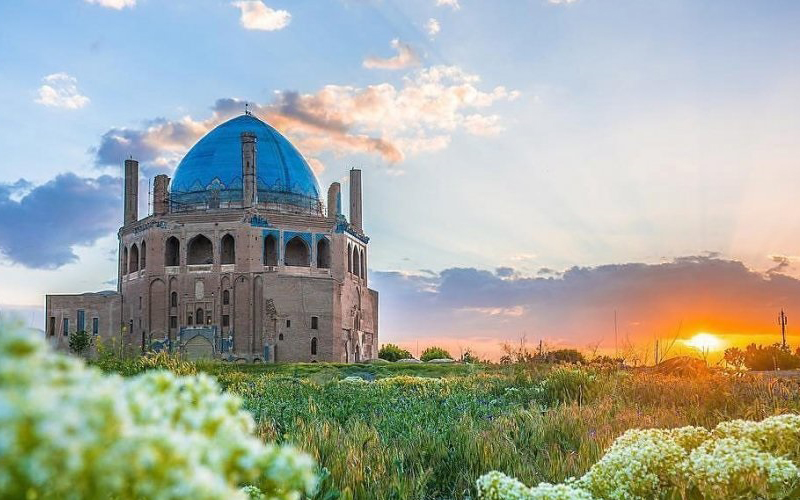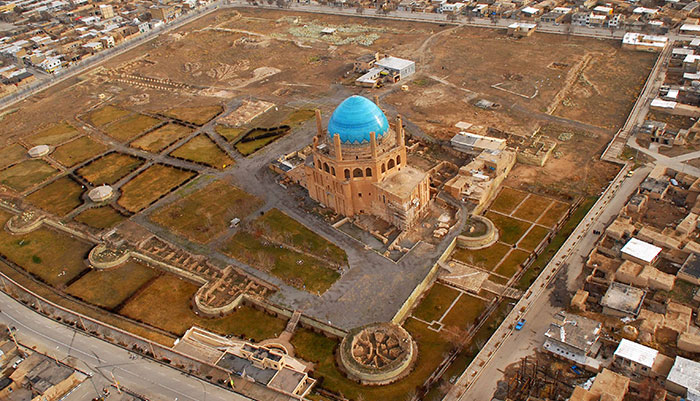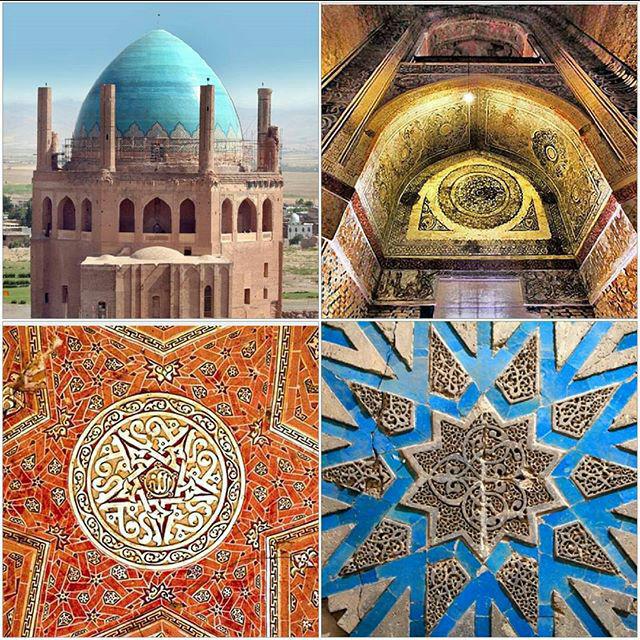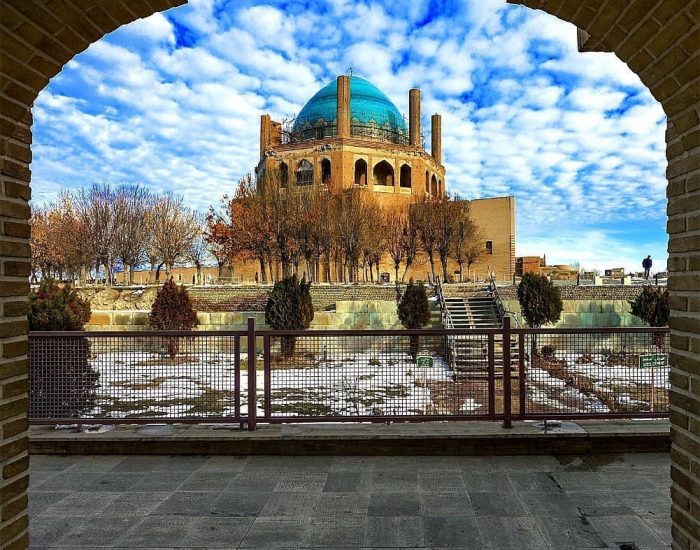The Dome of Soltaniyeh | the Story of Öljaitü's Dream
Standing tall amidst the Iranian plateau, the Dome of Soltaniyeh (Gonbad-e Soltaniyeh) is a magnificent mausoleum and mosque complex that embodies the pinnacle of Ilkhanid-era architecture.
Constructed in the late 13th century by Mongol ruler Öljeitü, the structure served as both his final resting place and a significant religious center.
As a UNESCO-listed marvel, it showcases innovative architecture, intricate tilework, and enduring historical significance.
Dome of Soltaniyeh Facts
- Renowned for its massive size, the Dome of Soltaniyeh ranks as the third-largest brick dome globally, following the Pantheon in Rome and the Hagia Sophia in Istanbul.
- The monument listed as one of the World Heritage Site of UNESCO in 2005.
- The tomb of the 8th king of Ilkhanate, Öljeitü is located at Dome of Soltaniyeh.
- The dome's 12 ribs and 8 sides hold symbolic significance, representing the 12 Imams in Shia Islam.
- The mausoleum's entrance aligns precisely with the direction of sunrise on the first day of spring.
- The dome's construction was initiated based on a dream of Öljaitü, adding a layer of symbolic significance to the structure. The dream involved gathering the remains of notable figures of Islam at the site, shaping the purpose and meaning behind the dome's existence.
Dome of Soltaniyeh History

Öljaitü, son of King Arghun and the seventh ruler of the Ilkhanate dynasty, commissioned the majestic Dome of Soltaniyeh in northwestern Iran. While the dynasty, a branch of the Mongols, initially brought turmoil with the invasion of Iran and destruction of major cities, Öljaitü's reign marked a shift towards reparations and cultural contributions.
Driven by a dream in which he envisioned gathering prominent Islamic figures, Öljaitü chose Soltaniyeh, initially the summer capital established by his father, as the main capital and began construction of the dome. Notably, his conversion to Shia Islam during a trip to Iraq, influenced by scholars and clerics, fueled his desire to relocate the remains of revered figures like Imam Ali and Imam Hussain to his mausoleum within the dome.
Öljaitü's grand plan involved transferring the imams' bodies from their current resting places in Najaf and Karbala, envisioning a modest tomb for himself alongside their grander entombment within the Soltanieh complex. However, this ambitious endeavor faced obstacles. Some attribute the hindrance to a dream he later had, while others point to opposition from Shia scholars. Regardless of the reason, his intentions ultimately remained unfulfilled.
Despite the Ilkhanate's initial destructive impact, Öljaitü's reign marked a turning point. The construction of the Soltanieh dome, driven by Öljaitü's dream and influenced by his newfound faith, stands as a symbol of architectural and historical significance during the dynasty's rule. While the scars of the invasion remain, the dome's enduring presence reflects a chapter of reconstruction and cultural influence within the broader narrative of Iranian history.
| Read more: Traditional Persian Architecture
Dome of Soltaniyeh Architectural Features

The dome is the central and most prominent feature of the structure. It is notable for its size and grandeur, standing as one of the largest brick domes globally, towering at 50 meters (164 feet). The dome sits atop an octagonal base, providing a geometric foundation for the structure. This octagonal shape is a common architectural motif in Islamic architecture.
Eight slender minarets, each 48 meters (157 feet) tall, flank the mausoleum, emphasizing its verticality and grandeur. These minarets served both aesthetic and functional purposes, acting as visual markers and calling towers for prayer. Elaborate tilework and intricate geometric patterns adorn the exterior of the dome. These decorations showcase the skilled craftsmanship of the artisans of the time and contribute to the artistic richness of the structure.
Four grand iwans (entrances) oriented towards the cardinal directions provide access to the mausoleum's interior. Each iwan features exquisite tilework and geometric designs.
The interior of the dome is decorated with detailed and ornate plasterwork. These decorative elements include calligraphy, arabesque designs, and geometric patterns, reflecting the Islamic artistic tradition.
Originally constructed as a mausoleum, the Dome of Soltaniyeh served as the final resting place for Öljaitü. The structure's design and purpose align with the traditional Islamic practice of constructing grand mausoleums for important figures.
| Suggestion: Dashkasan Temple - A Dragon Temple in Zanjan, Iran
Torbat Khaneh
Located on the southern side, the Torbat Khaneh holds immense religious significance. This section, measuring 17 meters long, 8 meters wide, and 16 meters high, houses sacred soil brought from Najaf and Karbala, holy sites for Shi'a Muslims. Öljaitü, the mausoleum's builder, even incorporated soil from the shrine of Imam Hussein into the construction, further emphasizing its spiritual importance.
The walls of the Mihrab, a prayer niche within the Torbat Khaneh, are adorned with inscriptions in Kufic and Thuluth script, and etched using the sacred soil, adding to the site's reverence.

Sardabeh
Beneath the Torbat Khaneh lies the Sardabeh, a crypt serving as Öljaitü's final resting place. This section reflects respect for the deceased, featuring a low entrance symbolizing humility before the dead. While details about the Sardabeh's interior remain largely unknown, its presence underscores the mausoleum's primary function as a tomb.
| Suggestion: Step Back in Time at Behestan Castle in Zanjan
Gonbad Khaneh
This groundbreaking feature, a world-first for its time, employed two layers of brick separated by an air gap. This ingenious design enhanced structural stability and thermal insulation, ensuring the dome's resilience against earthquakes and harsh weather conditions.
Intriguingly, the dome incorporates strategically placed light wells. These weren't just for illumination; they also served as early sundials, allowing accurate timekeeping in the era before modern clocks.
Landmarks near the Dome of Soltaniyeh
- Zanjan Grand Bazaar
- Zanjan Historical City Center
- Historical Salar Bath
- Molla Hasan Kashi Tomb
- Qale-ye-Soltāniye
- Rakhtshooy Khaneh Edifice
- Saltmen Museum
- Jameh Mosque of Zanjan
- Zanjan Anthropology Museum
Dome of Soltaniyeh Location and Access
Address: Soltaniyeh City, Zanjan Province, Iran
Opening Hours: 08:00 - 18:30
The Dome of Soltaniyeh is situated in Soltaniyeh City within the Zanjan Province of Iran. Visitors can explore the monument during the specified opening hours from 08:00 to 18:30.
| Read more: Top 14 Religious Tourist Attractions in Iran
Best Time to Visit the Dome of Soltaniyeh

The climate in Soltaniyeh City differs from the central regions of Iran, characterized by colder temperatures. Winters experience icy and snowy conditions, while summers are generally pleasant and cool. The recommended time to visit the Soltaniyeh Dome is during the months of May, June, July, and August when the weather is more favorable. Alternatively, October and November offer an opportunity to experience the autumnal nature and captivating views.
It is advised against traveling to Soltaniyeh during the winter months due to extremely cold weather conditions. Additionally, during this period, roads may become icy and slippery, posing potential challenges for visitors. Therefore, planning a visit to Soltaniyeh in winter is not recommended for a safer and more enjoyable experience.
Bottom Line
The Dome of Soltaniyeh stands not only as a remarkable architectural marvel with its grandeur and historical significance but also as a gateway to the cultural tapestry of the Zanjan Province.
Whether drawn by the allure of the Dome's construction, the rich history of the region, or the vibrant local culture, a visit to Soltaniyeh promises a multifaceted journey through time and tradition.
Share your story!
Comment below and let us know about your Experience.
Your story inspires others!


Comment
Leave a Comment